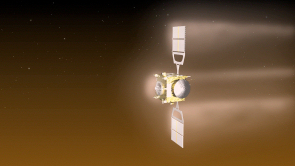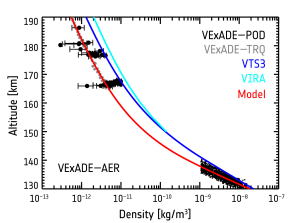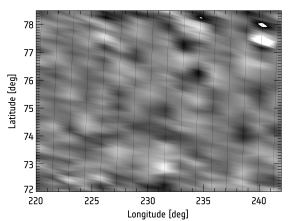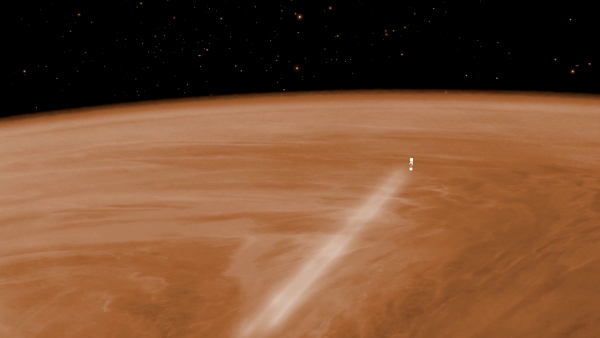Venus Express' swansong experiment sheds light on Venus' polar atmosphere
19 April 2016
Some of the final results sent back by ESA's Venus Express before it plummeted down through the planet's atmosphere have revealed it to be rippling with atmospheric waves – and, at an average temperature of -157°C, colder than anywhere on Earth.As well as telling us much about Venus' previously-unexplored polar regions and improving our knowledge of our planetary neighbour, the experiment holds great promise for ESA's ExoMars mission, which is currently winging its way to the Red Planet. The findings were published in the journal Nature Physics on 11 April 2016.
ESA's Venus Express arrived at Venus in 2006. It spent eight years exploring the planet from orbit, vastly outliving the mission's planned duration of 500 days, before running out of fuel. The probe then began its descent, dipping further and further into Venus' atmosphere, before the mission lost contact with Earth (November 2014) and officially ended (December 2014).
However, Venus Express was industrious to the end; low altitude orbits were carried out during the final months of the mission, taking the spacecraft deep enough to experience measurable drag from the atmosphere. Using its onboard accelerometers, the spacecraft measured the deceleration it experienced as it pushed through the planet's upper atmosphere – something known as aerobraking.
 |
|
Venus Express aerobraking. Credit: ESA - C. Carreau |
"Aerobraking uses atmospheric drag to slow down a spacecraft, so we were able to use the accelerometer measurements to explore the density of Venus' atmosphere," said Ingo Müller-Wodarg of Imperial College London, UK, lead author of the study. "None of Venus Express' instruments were actually designed to make such in-situ atmosphere observations. We only realised in 2006 – after launch! – that we could use the Venus Express spacecraft as a whole to do more science."
When Müller-Wodarg and colleagues gathered their observations Venus Express was orbiting at an altitude of between 130 and 140 kilometres near Venus' polar regions, in a portion of Venus' atmosphere that had never before been studied in situ.
Previously, our understanding of Venus' polar atmosphere was based on observations gathered by NASA's Pioneer Venus probe in the late 1970s. These were of other parts of Venus' atmosphere, near the equator, but extrapolated to the poles to form a complete atmospheric reference model.
These new measurements, taken as part of the Venus Express Atmospheric Drag Experiment (VExADE) from 24 June to 11 July 2014, have now directly tested this model – and reveal several surprises.
 |
| Density profiles of Venus' polar atmosphere. Credit: Figure courtesy of I. Müller-Wodarg (Imperial College London, UK) |
For one, the polar atmosphere is up to 70 degrees colder than expected, with an average temperature of -157°C (114 K). Recent temperature measurements by Venus Express' SPICAV instrument (SPectroscopy for the Investigation of the Characteristics of the Atmosphere of Venus) are in agreement with this finding.
The polar atmosphere is also not as dense as expected; at 130 and 140 km in altitude, it is 22% and 40% less dense than predicted, respectively. When extrapolated upward in the atmosphere, these differences are consistent with those measured previously by VExADE at 180 km, where densities were found to be lower by almost a factor of two.
"This is in-line with our temperature findings, and shows that the existing model paints an overly simplistic picture of Venus' upper atmosphere," added Müller-Wodarg. "These lower densities could be at least partly due to Venus' polar vortices, which are strong wind systems sitting near the planet's poles. Atmospheric winds may be making the density structure both more complicated and more interesting!"
Additionally, the polar region was found to be dominated by strong atmospheric waves, a phenomenon thought to be key in shaping planetary atmospheres – including our own.
"By studying how the atmospheric densities changed and were perturbed over time, we found two different types of wave: Atmospheric gravity waves and planetary waves," explained co-author Sean Bruinsma of the Centre National D'Etudes Spatiales (CNES), France. "These waves are tricky to study, as you need to be within the atmosphere of the planet itself to measure them properly. Observations from afar can only tell us so much."
 |
| Mapping the density waves in Venus' lower thermosphere. Credit: ESA/Venus Express/VExADE/Müller-Wodarg et al., 2016 |
Atmospheric gravity waves are similar to waves we see in the ocean, or when throwing stones in a pond, only they travel vertically rather than horizontally. They are essentially a ripple in the density of a planetary atmosphere – they travel from lower to higher altitudes and, as density decreases with altitude, become stronger as they rise. The second type, planetary waves, are associated with a planet's spin as it turns on its axis; these are larger-scale waves with periods of several days.
We experience both types on Earth. Atmospheric gravity waves interfere with weather and cause turbulence, while planetary waves can affect entire weather and pressure systems. Both are known to transfer energy and momentum from one region to another, and so are likely to be hugely influential in shaping the characteristics of a planetary atmosphere.
"We found atmospheric gravity waves to be dominant in Venus' polar atmosphere," added Bruinsma. "Venus Express experienced them as a kind of turbulence, a bit like the vibrations you feel when an aeroplane flies through a rough patch. If we flew through Venus' atmosphere at those heights we wouldn't feel them because the atmosphere just isn't dense enough, but Venus Express' instruments were sensitive enough to detect them."
Venus Express found atmospheric waves at an altitude of 130-140 km that the team think originated from the upper cloud layer in Venus' atmosphere, which sits at and below altitudes of approximately 90 km, and a planetary wave that oscillated with a period of five days. "We checked carefully to ensure that the waves weren't an artefact of our processing," said co-author Jean-Charles Marty, also of CNES.
This is not just a first for Venus Express; while the aerobraking technique has been used for Earth satellites, and was previously used on NASA-led missions to Mars and Venus, it had never before been used on any ESA planetary mission.
However, ESA's ExoMars Trace Gas Orbiter, which launched earlier this year, will use a similar technique. "During this activity we will extract similar data about Mars' atmosphere as we did at Venus," added Håkan Svedhem, project scientist for ESA's ExoMars 2016 and Venus Express missions.
"For Mars, the aerobraking phase would last longer than on Venus, for about a year, so we'd get a full dataset of Mars' atmospheric densities and how they vary with season and distance from the Sun," added Svedhem. "This information isn't just relevant to scientists; it's crucial for engineering purposes as well. The Venus study was a highly successful test of a technique that could now be applied to Mars on a larger scale – and to future missions after that."
Background information
The findings were published in a paper entitled "In situ observations of waves in Venus' polar lower thermosphere with Venus Express aerobraking" by Muller-Wodarg et al., in Nature Physics on 11 April 2016 (doi: 10.1038/NPHYS3733).
Venus Express is Europe's first mission to Venus. It was launched from Baikonur Cosmodrome on 9 November 2005 on a Soyuz-Fregat launcher, and was inserted into Venus orbit on 11 April 2006. The payload includes a combination of spectrometers, spectro-imagers, and imagers covering a wavelength range from ultraviolet to thermal infrared, a plasma analyser and a magnetometer. Between May and July 2014, an aerobraking campaign was performed with Venus Express – the first performed by an ESA spacecraft – resulting in unique observations of the planet's rarefied outer atmosphere and a change in the spacecraft's orbital period from 24 hours to 22 hours 20 minutes.
Science highlights from the Venus Express mission can be found here.
For further information, please contact
Ingo Müller-Wodarg
Blackett Laboratory, Imperial College London, UK
Email: i.mueller-wodarg![]() imperial.ac.uk
imperial.ac.uk
Sean Bruinsma
Centre National D'Etudes Spatiales (CNES), France
Email: sean.bruinsma![]() cnes.fr
cnes.fr
Jean-Charles Marty
Centre National D'Etudes Spatiales (CNES), France
Email: Jean-Charles.Marty![]() cnes.fr
cnes.fr
Håkan Svedhem
ESA project scientist for ExoMars 2016 and Venus Express
Directorate of Science
European Space Agency
Tel: +31-71-565-3370
Email: hsvedhem![]() cosmos.esa.int
cosmos.esa.int





